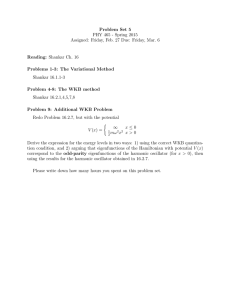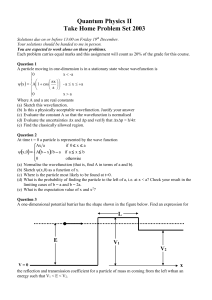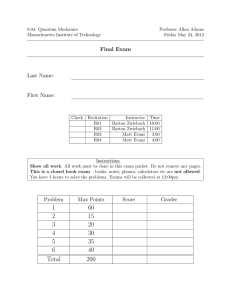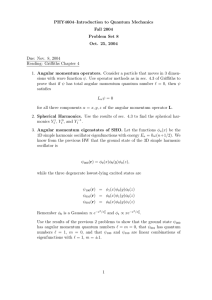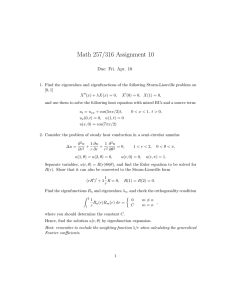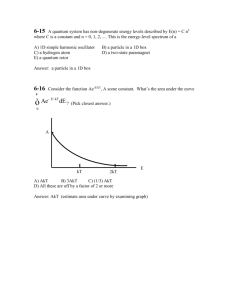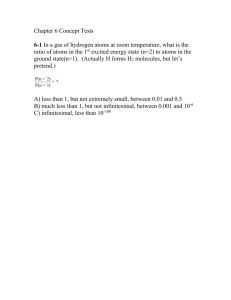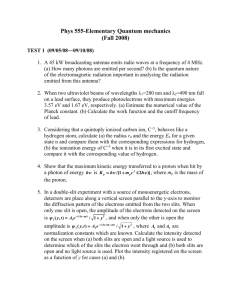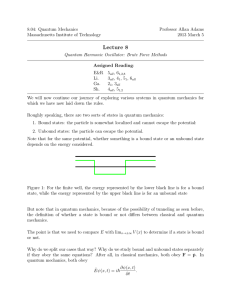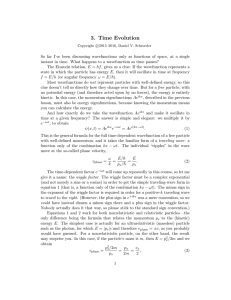Lecture 6 Quantum Mechanical Systems and Measurements Today’s Program:
advertisement
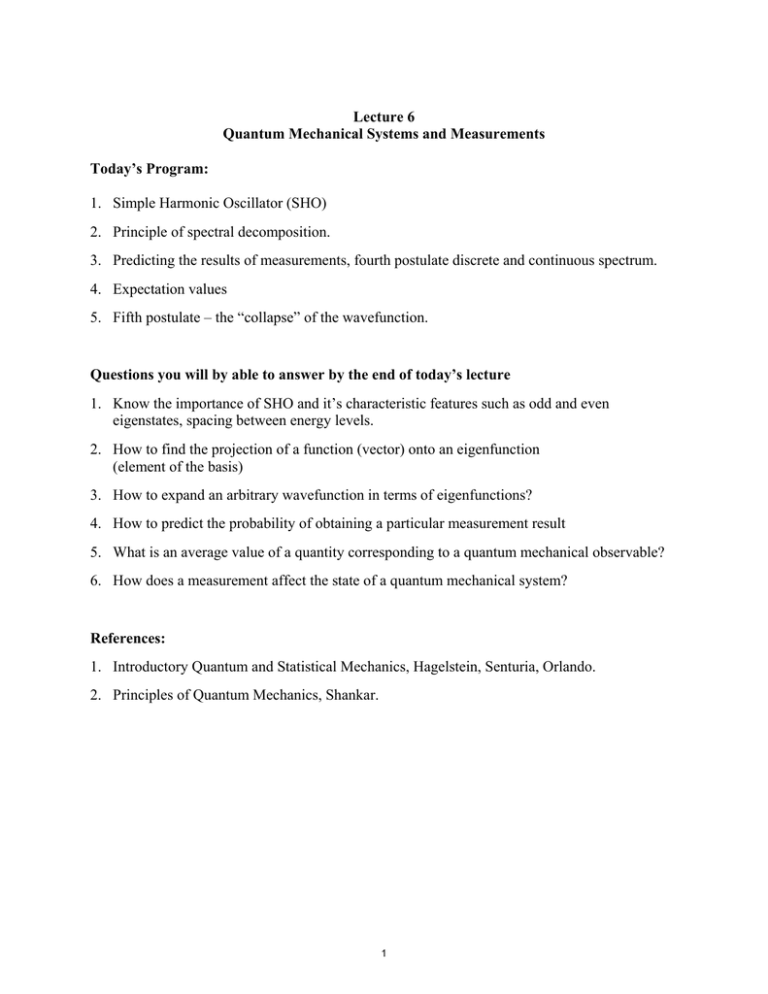
Lecture 6 Quantum Mechanical Systems and Measurements Today’s Program: 1. Simple Harmonic Oscillator (SHO) 2. Principle of spectral decomposition. 3. Predicting the results of measurements, fourth postulate discrete and continuous spectrum. 4. Expectation values 5. Fifth postulate – the “collapse” of the wavefunction. Questions you will by able to answer by the end of today’s lecture 1. Know the importance of SHO and it’s characteristic features such as odd and even eigenstates, spacing between energy levels. 2. How to find the projection of a function (vector) onto an eigenfunction (element of the basis) 3. How to expand an arbitrary wavefunction in terms of eigenfunctions? 4. How to predict the probability of obtaining a particular measurement result 5. What is an average value of a quantity corresponding to a quantum mechanical observable? 6. How does a measurement affect the state of a quantum mechanical system? References: 1. Introductory Quantum and Statistical Mechanics, Hagelstein, Senturia, Orlando. 2. Principles of Quantum Mechanics, Shankar. 1 Importance of the harmonic oscillator in physics: Recall our first lecture when we analyzed lattice vibrations in a framework of masses connected by springs. In that system the classical Hamiltonian for the particle connected by a spring to p2 1 2 another particle or a wall was: H x, p K x. 2m 2 A compressed or stretched spring in this case exerts a restoring force onto a particle. This restoring force is proportional to the displacement F=-Kx. This restoring force effectively places the particle into a potential, which has a shape of the potential energy of the spring, i.e. 1 V x K 2 x . This quadratic potential is called Harmonic oscillator potential and any system 2 that exhibits a linear restoring force = parabolic potential can be described by an identical set of concepts. The great importance of this particular potential is that any smooth potential that has a minimum behaves to a certain extent like a harmonic oscillator (provided that we are considering small deviations from this minimum point). The Taylor expansion of a smooth potential about it’s minimum x0 is: V 2 3 1 2V V x V x0 x x0 2 x x0 O x x0 2! x xx x xx0 0 0 since V is a minimum at x0 near the minimum the potential has a parabolic shape. Examples of physical systems which can be described by a harmonic oscillator model include: vibrational motion of diatomic molecules mention the Leonard Jones 6-12 potential, vibration of atoms in a solid (phonons) and others. Quantum Mechanical quantitative harmonic oscillator I The system: While we can imagine our physical system as a particle oscillating on the spring. It is simpler to visualize it as a particle rolling from side to side in a parabolic potential: 2 II The classical energy function of the system: p2 K p2 1 2 p2 1 E V x Kx m 2 x 2 H x, p , m 2m 2m 2 2m 2 Using the Hamilton’s equations one can solve for the classical trajectory: dx H p x t x(t 0)cos t dt p m d 2x d 2x K 2 x 2 2x 0 m dt dt H p t x(t 0)m sin t dp Kx dt x III QM Hamiltonian operator: H x, p Ĥ x̂, p̂ 2 2 1 p̂ 2 ˆ V x m 2 x 2 2 2m 2m x 2 IV Identify energy eigenvalues and eigenfunctions As usual we focus on finding the energy eigenfunctions in cases, which involve Hamiltonians without explicit time dependence. 2 2 1 2 2 ˆ ˆ pˆ u x Eu x H x, m x u x Eu x 2 2m x 2 The energy eigenfunctions are: 1 m 1 m x2 u0 x e 2 1/4 1/4 1 m 2 4 m x u1 x xe 2 1/4 3/4 1 m m 2 1 m x2 u2 x x 1 e 2 2 4 1/4 1/4 The general form is, 1 m 2 x 2 H x H x is called a hermite polynomial. un x e n n 3 Figure removed due to copyright restrictions. Chp. V, Fig. 5: Hagelstein, Peter L., Stephen D. Senturia, and Terry P. Orlando. Introductory Applied Quantum and Statistical Mechanics. Wiley, 2004. See Mathematica program: HermiteH[n, x] gives the Hermite polynomial Hn(x). The corresponding energy eigenvalues: 1 En n , n 0,1,2... 2 Consequences: 1. The minimal energy is always greater than 0 – no classical analogue. 2. The eigenfunctions have a definite parity. The lowest energy eigenfunction is even. 3. Energy is quantized, energy spectrum is discrete – no classical analogue, result of being bound. 4. Spacing between the energy levels is constant. 4 Measuring physical quantities in Quantum Mechanics. Recall the properties of Hermitian operators. In the Previous Lecture we learned that any wavefunction can be represented as a linear superposition of eigenfunction of a Ψ Hermitian operator. C2 ψ2 ψ1 A good way to visualize the decomposition of wavefunction: r, t C11 r, t C2 2 r, t ... is a vector form. Akin to the basis vectors illustrated bellow we can use eigenfunctions as “basis functions”. C1 Principle of spectral decomposition: Since the eigenfunctions (or eigenvectors) form a complete basis (see properties of Hermitian operators) we can use express any state as a linear combination of the eigenfunctions (or eigenvectors). Typically the attention in QM problems is focused on obtaining a particular basis set namely that of the energy eigenfunctions. This in turn enables us to analyze the possible energy of the system (energy eigenvalues) and even make predictions about the probability of obtaining any particular result given an initial state. 5 MIT OpenCourseWare http://ocw.mit.edu 3.024 Electronic, Optical and Magnetic Properties of Materials Spring 2013 For information about citing these materials or our Terms of Use, visit: http://ocw.mit.edu/terms.
